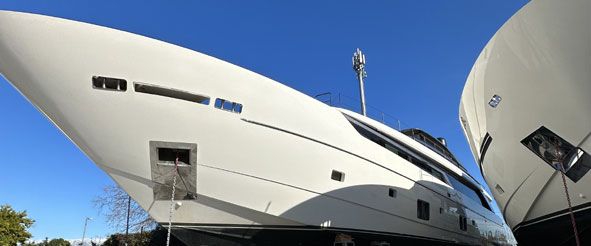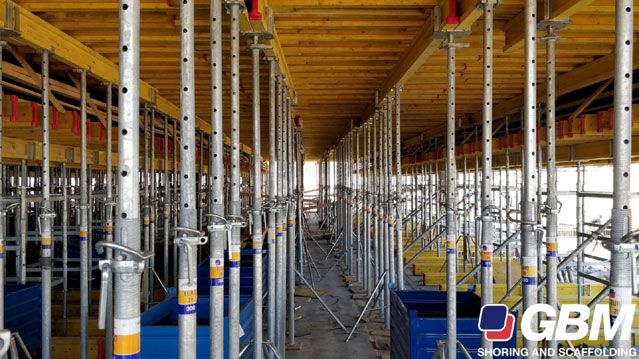Închirierea popilor: GBM introduce popii cu capacitate portantă ridicată "coloraţi"
Popi pentru construcţii: când e mai convenabil să îi cumpăraţi şi când să îi închiriaţi. Iată cum să alegeţi.

Construction props: buy or rent?

Worksite materials represent one of the most relevant cost items for the construction firm when it comes to constructing buildings. Props, scaffolds, beams and formworks are examples of costs often deemed secondary by the end customer (the person buying the house undergoing construction or renovation for instance). This being based on an assumption that it is not him/her who meets the cost directly.
It is easy to leave the burden of availability of instruments appropriate to complete the works squarely on the shoulders of the firm carrying out the works by default.
However, it also happens that small and medium construction enterprises get awarded construction contracts requiring a higher need for props and scaffolds than usually available in their stores. Which is the swiftest and most pocket-friendly way to overcome this challenge? How convenient is it to prepare the customer a quick quote including costs (and the relative depreciation) of materials required to get the job done? In a few words: are you better off renting or buying props? And in any case: when is it convenient to stake on new material and when is second-hand material the best option?
Your answer is right there in the question: "when it is convenient".
Three reasons why renting props is the convenient option
The Italian market is not one of the best when it comes to renting props due to “historical reasons”.
An average businessman usually reasons in terms of owning the machinery and equipment: “I had rather buy than rent". This enables firms to include expenses for purchasing materials among the business expenditure records, with ensuing tax benefits.
However, opting to purchase makes business sense only if the construction firm actually benefits from this option. Buying is the right option in case of extended use of the material. On the contrary, if the material is to be used for a short time, (executing works regarding just one project that will be hardly replicated elsewhere by the same firm), renting makes more business sense.
This implies relieving small and medium construction companies from the burden of needing extra props in their stores, having to find someone willing to buy them, running the risk of reselling (to a competitor) at a much lower price with respect to the purchase.
Props for the Italian construction industry: the best and... the worst handled worldwide.
A second reason why people often shy away from renting in Italy lies in the fact that "light props" (those red ones you often see at worksites across Italy, to an extent they are often referred to as "Italy props") dominate the construction landscape.
This type of prop is less resistant to mishandling and improper use. Disassembling is a typical case: instead of rotating the nut to release the locking elements, masons find it much quicker to hit hard on the base with a hammer and drop it to the ground. This brutal handling obviously ruins it to an extent of jeopardising its future use. And this "telescopic prop", once capable of bearing a slab weighing tons, suddenly becomes totally useless in the construction industry.
Thus, rental props must be in a position to resist against the toughest stress both during disassembly and, above all, at work.
A third reason why it is definitely more convenient to rent this kind of material rather than buy lies in the type of prop that the construction firm needs unexpectedly. Many small and medium construction companies have light props, which are usually appropriate for constructing detached houses and small villas. However, whenever there arises the need to construct something more "complex", one needs approved material capable of bearing heavier loads.
Heavy duty and coloured nut
In order to meet all these needs, props rental almost exclusively regards heavy duty props.
They are used especially when constructing buildings requiring a particularly thick slab, such as condominium, skyscrapers, hospitals, multi-storey parking facilities, basement parking worksites and the like for instance.
Constructors are required to use Class B, Class D and Class E DIN EN 1065 props and thus can save by renting heavy duty props.
Based in Brescia, GBM Building Equipments sells, rents and hires (even leasing) props and scaffolds to large, medium and small construction companies in Italy and across the globe. Props with a distinctive feature: a coloured nut with customised colours upon request.
What's the purpose of a coloured nut?
To distinguish the material rented by customers at the worksite. Having been in the market for decades, we - at GBM - know that it is common to paint part of the pipe in a given identifying colour so as to distinguish the owners of the various props present in the same worksite.
GBM introduced the coloured nut with the aim of facilitating instantaneous identification of one's material to the eye and with the aim of avoiding any kind of complexity when doing so.
The colour of the nut can be personalised and requested by the customer during quotation, alongside a more special customisation: the customer’s logo, supplier’s identification code, special information on the product and its specifications.
From tomorrow, when you step into a worksite, try and look around: if you don’t see the usual props with grey nuts, chances are that you are looking at GBM props.
Last update:
News

GBM's shipbuilding scaffoldings

Popi necesari pentru a susține un solar: ghid pentru a stabili distanțele, categoriile și cantitățile
Contact: informaţii, preţuri şi oferte de preţ.
Doriţi mai multe informaţii despre produsele GBM? Contactaţi-ne!
 Italiano
Italiano English
English Deutsch
Deutsch Français
Français Português
Português Polski
Polski Български
Български Română
Română Español
Español Русский
Русский Српски
Српски Hrvatski
Hrvatski Slovenski
Slovenski Shqip
Shqip Magyar
Magyar English (US)
English (US)
